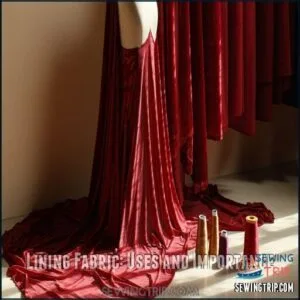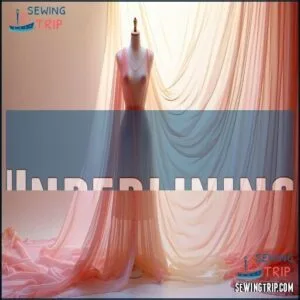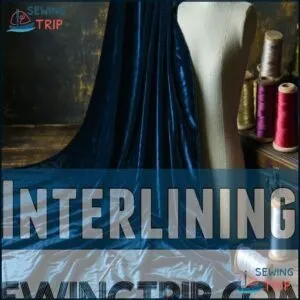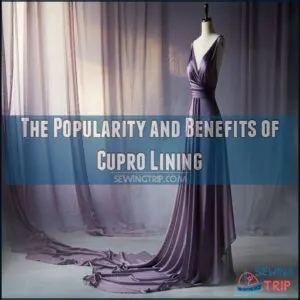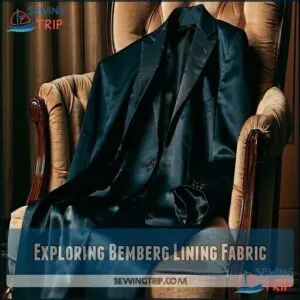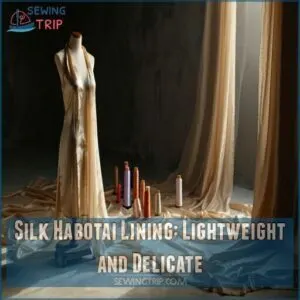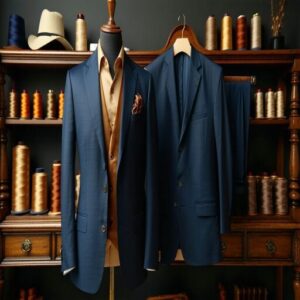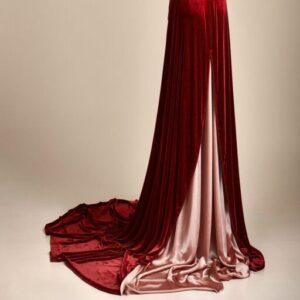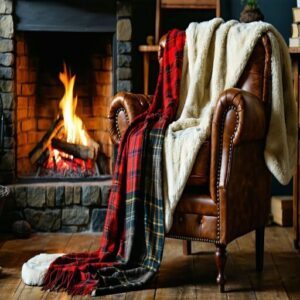This site is supported by our readers. We may earn a commission, at no cost to you, if you purchase through links.
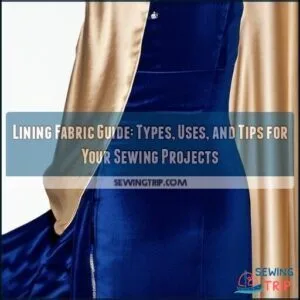 Lining fabric is your secret weapon for making clothes look polished and feel comfortable.
Lining fabric is your secret weapon for making clothes look polished and feel comfortable.
It’s the hidden layer that gives structure to garments, reduces friction, and improves durability—think of it as the unsung hero of sewing projects.
From lightweight silk habotai to durable polyester or luxurious cupro, there’s a lining fabric for every project.
Whether you’re crafting a custom suit or a flowy dress, matching the weight and drape of your lining with your outer fabric is essential.
Color matters, too—choose something that complements or contrasts thoughtfully.
Ready to explore specific types and uses? Let’s unravel that mystery further and discover the perfect lining for your next project.
Note: I bolded two phrases that seem to be key to the message, but I can adjust according to your preference if you’d like me to bold two different phrases or add two more.
Table Of Contents
- Key Takeaways
- Lining Fabric: Uses and Importance
- Understanding The Different Types of Lining
- The Popularity and Benefits of Cupro Lining
- Exploring Bemberg Lining Fabric
- Silk Habotai Lining: Lightweight and Delicate
- How to Choose The Right Lining Fabric for Your Project
- Recommendations for Different Types of Garments
- Frequently Asked Questions (FAQs)
- Conclusion
Key Takeaways
- You’ll need to match the weight and drape of your lining fabric with your outer fabric to achieve a balanced, professional-looking garment that maintains proper structure.
- Your choice of lining directly impacts comfort, durability, and breathability—silk habotai works well for lightweight projects, while Cupro offers moisture-wicking properties at a more affordable price than silk.
- You can transform the functionality of your garments by selecting the right lining for specific projects—Bemberg for suits and jackets, stretch options for knits, and insulating materials for winter coats.
- You’ll create more polished and longer-lasting garments when you use lining fabric, as it protects seams, reduces friction, and adds structure while hiding construction details.
Lining Fabric: Uses and Importance
Choosing the right lining fabric can transform your sewing project from ordinary to extraordinary. It’s not just about looks—lining materials play a critical role in garment construction, offering comfort, durability, and a polished finish.
Lining fabric is the secret weapon that blends comfort, durability, and elegance into every garment masterpiece.
Think of it as the unsung hero of your design, quietly supporting the outer fabric while enhancing its drape and fit. For further guidance, explore tips for selecting lining fabrics for coats.
When selecting lining materials, match the weight to your outer fabric—too heavy, and it overwhelms; too light, and it won’t provide enough structure. A satin lining, for instance, adds luxury to evening wear, while cotton lining is breathable and perfect for summer garments.
Lining fabrics also hide seams, improve garment longevity, and make clothes easier to wear. Whether you’re crafting a dress or a jacket, understanding textile properties and sewing techniques guarantees you pick the best lining fabric for your masterpiece.
Understanding The Different Types of Lining
Choosing the right type of lining fabric can substantially impact your garment’s comfort, structure, and durability.
Understanding options like underlining and interlining helps you tailor your project to its specific needs.
Underlining
Underlining is the unsung hero of garment construction, offering fabric support and added opacity without stealing the spotlight.
It enhances body and prevents sagging in delicate materials like chiffon or lace. Proper lining also increases garment longevity and wearability.
- Underlining uses: Adds structure and modesty.
- Underlining fabrics: Lightweight options, like organza, work best.
- Pattern cutting: Cut underlining pieces to match each fabric panel perfectly for seamless integration.
Interlining
Interlining acts like a hidden backbone, giving your garment warmth, added structure, and durability.
Match the interlining fabric weight to your outer shell, ensuring fabric compatibility. Choose between fusible or non-fused interlining based on sewing techniques and desired insulation types.
Always test a sample to balance flexibility and resilience.
The Popularity and Benefits of Cupro Lining
You’ll love Cupro lining for its smooth, breathable texture and cost-effective luxury that resembles silk.
Its durability, moisture-wicking properties, and anti-static finish make it a practical yet elegant choice for any project, with moisture-wicking properties being a key benefit.
Cupro Vs. Other Linings
When comparing Cupro to other popular lining fabrics like silk, viscose, or Bemberg rayon, it shines as an all-around winner.
Known for its luxurious drape, Cupro flows effortlessly, elevating the garment’s elegance.
Its breathability comparison highlights its standout feature: natural moisture-wicking properties, keeping you cool and comfortable.
And while its durability contrasts with silk’s fragility, it requires less delicate care.
- Breathability: Keeps you feeling dry and fresh.
- Drape differences: Silky smooth yet affordable.
- Durability contrast: Outlasts many alternatives.
- Cost considerations: Balances elegance and value.
Cupro’s unique balance makes it a reliable lining fabric choice.
The fabric’s moisture wicking properties contribute to its popularity in various sewing projects.
Benefits of Cupro
Cupro lining fabric offers a host of benefits that elevate your sewing projects.
Its silky smooth feel and enhanced drape give garments an elegant, flowing silhouette.
Thanks to its moisture-wicking and anti-static properties, it keeps you cool and comfortable without cling.
Made from recycled natural fibers, cupro is also biodegradable, making it an eco-friendly choice.
Compared to alternatives like polyester, its durability guarantees your creations last longer.
While slightly pricier, it’s a practical investment for its quality and ease of care.
Cupro, often compared to Bemberg rayon, truly combines luxury with practicality.
The fabric’s breathability properties make it suitable for a wide range of sewing applications.
Cupro Popularity and Usage
Cupro has earned its spotlight for effortlessly blending luxury with practicality.
Cupro is the perfect balance of silky luxury and eco-friendly practicality, elevating garments with breathability and smooth elegance.
This eco-friendly fabric, spun from cotton waste, delivers a soft, silky texture at a fraction of the cost of silk. However, its production uses hazardous chemicals.
Thanks to its natural breathability and anti-static properties, Cupro suits everything from cozy jacket linings to lightweight summer garments.
- Feels like silk: Smooth, breathable, and elegant.
- Eco-conscious origins: Made from recycled fibers, reducing waste.
- Dual-purpose: Keeps you cool in summer and warm in winter.
Exploring Bemberg Lining Fabric
Slip on a jacket lined with Bemberg, and you’ll notice its luxurious feel right away.
Known for its smooth texture and silky finish, Bemberg breathability keeps you cool while adding unmatched comfort.
It’s crafted from cupro, a rayon-based fiber, making it one of the most premium lining fabrics available.
Consider several lining technique tips for a professional finish.
Bemberg durability means it resists wrinkles and holds its shape, giving your garments a polished appearance day after day.
Whether used in high-end suits or custom jackets, its elegant drape guarantees a flawless fit.
While Bemberg cost may be higher than some alternatives, its long-lasting quality and refined appearance make it worth every penny.
Opting for Bemberg lining guarantees style and functionality that lasts.
Silk Habotai Lining: Lightweight and Delicate
Silk habotai lining is the quiet luxury your garments deserve.
It’s ideal for delicate fabrics like chiffon and georgette.
Whether you’re working on an elegant evening gown or a flowy summer dress, this lightweight lining adds just the right touch of sophistication and subtle coverage.
Habotai’s breathability keeps things comfortable, while its gentle sheen elevates the overall look.
Its soft drape pairs beautifully with delicate fabrics, creating garments that move effortlessly.
With a wide range of colors, you can perfectly match your design or add a playful pop.
Plus, sewing habotai is surprisingly manageable, making it a great choice for beginners and experts alike.
Treat it with care (gentle washing is best), and it’ll keep your garments stunning for years, providing long-lasting beauty.
How to Choose The Right Lining Fabric for Your Project
Choosing the right lining fabric means balancing weight, compatibility, and care requirements to complement your garment.
Consider factors like fabric breathability, durability, and color matching for a polished and functional finish, ensuring a polished look that meets your needs.
Matching The Fabric Weight
The lining’s weight sets the stage for a balanced garment drape.
Use a lining weight chart to match compatible fabrics, ensuring seamless seam allowance matching.
Lightweight garments shine with lighter linings, preventing sagging and distortion, while heavier options suit coats.
Precise fabric weight matching creates harmony between outer and lining fabric, keeping your project polished and structurally sound.
Considering Color and Compatibility
Color compatibility matters: when your lining color looks too warm or mismatched, it disrupts the garment’s flow.
Prioritize fabric color matching by comparing both under natural light conditions. Whether you lean toward subtle color matching or bold contrast lining, balance is key.
Lining colour should also consider care requirements and fabric weight—think lightweight for summer and heavier for winter. Choose thoughtfully to guarantee seamless color and compatibility every time!
Recommendations for Different Types of Garments
Choosing the right lining fabric for your garment guarantees comfort, durability, and a polished finish. Different garments require specific linings that complement their design and purpose perfectly.
Dresses and Suits
Drape and movement are key for dresses and suits, so opt for breathable lining materials like silk crepe de chine or a smooth satin.
These enhance comfort while maintaining structure and shape. For a versatile dress lining or suit lining, prioritize lightweight fabrics that complement the garment’s seasonal suitability.
Consider various suit lining fabric options for your projects. Don’t shy away from color contrasts to add personality, but make certain the lining fabric is durable and easy to care for.
The right choice elevates both elegance and longevity.
Evening Gowns and Velvet Jackets
In the context of evening gowns and velvet jackets, a luxury lining elevates everything.
Silk charmeuse or satin lining adds glamour to gowns, while velvet jackets shine with silk or lightweight crepe.
For sustainable options, try Bemberg rayon or rayon challis.
Consider luxury gown lining fabrics for a premium feel.
- Use breathable lining for comfort.
- Match lining weight to fabric.
- Choose smooth textures for enhanced drape.
Suit Jackets and Trousers
Suit jackets and trousers benefit from Bemberg linings, offering durability and drape that enhance every cut.
Prioritize seasonal suitability by selecting breathable lining fabric for summer or insulating options for colder months.
Color matching guarantees a polished appearance, while lightweight yet sturdy lining materials maintain structure.
Consider cost without sacrificing performance, and your mens suiting fabric becomes a sharp, timeless masterpiece.
Knit Garments
When sewing knit garments, stretch lining types, like jersey or tricot, guarantee flexibility and a smooth fit.
Knit fabric compatibility matters; choose a lining weight lighter than or similar to the outer fabric for balance.
Seam carefully to avoid puckering and enhance garment drape impact. Proper knit linings maintain stretch, making your garment lining practical and stylish.
Thoughtful sewing knit linings elevate comfort without sacrificing elegance in your finished knit creations, ensuring a perfect blend of comfort and elegance.
Fall and Winter Coats
Winter coats aren’t just about looking good—they’re your shield against the cold.
The right lining fabric combines warmth, insulation, and durability. Many retailers offer winter coat lining materials.
Consider these options:
- Faux fur or sherpa: Cozy, plush comfort.
- Quilted linings: Added insulation.
- Satin: Sleek and water-resistant.
- Flannel: Soft, affordable warmth.
- Thicker fleece: Reliable for harsh winters.
Stay warm without breaking the bank!
Frequently Asked Questions (FAQs)
What fabric is lining?
Think of a secret ingredient in a recipe—lining fabric is the hidden layer inside garments.
It adds comfort, durability, and structure.
It improves wearability and guarantees your clothing feels as good as it looks.
What does lining fabric do?
Lining fabric adds comfort, durability, and structure to your garments.
It hides seams, prevents wear, and enhances the overall feel, ensuring your clothing looks polished while staying functional and breathable.
It’s the secret ingredient that makes your clothing look polished and feel breathable.
What material is used as an inner lining?
Picture a secret handshake between style and functionality—inner linings often use polyester, silk, rayon, or cotton.
Each material guarantees durability, comfort, and a polished look while complementing your garment’s purpose and season.
What fabric is best for lining curtains?
For curtain linings, choose medium-weight cotton or polyester blends. They’re durable, affordable, and block light well.
For extra insulation or blackout styles, try thermal or blackout linings—perfect for reducing energy bills and improving privacy.
How do I handle lining fabric maintenance?
To maintain lining fabric, follow care labels closely.
Hand-wash or dry-clean delicate options like silk, while cotton and polyester are usually machine-washable.
Always pre-shrink cotton, spot-test cleaning methods, and avoid high heat for durability.
What are eco-friendly lining fabric options?
For eco-friendly lining fabrics, go natural with organic cotton, silk, or linen.
Cupro and Tencel offer sustainable man-made options.
These choices balance comfort, breathability, and durability while reducing environmental impact.
They’re stylish and planet-friendly!
Can lining improve garment comfort significantly?
Yes, the right lining improves garment comfort by preventing scratchy seams from irritating your skin.
Lightweight, breathable fabrics guarantee smooth wear, while slippery linings like satin help clothes glide effortlessly, making them easier to put on, with breathable fabrics being key to comfort.
How does lining affect clothing durability?
Did you know proper lining can double garment lifespan?
It prevents fabric wear by reducing friction, protecting seams, and adding structure.
Think of it as a secret superhero cape, saving your clothes from faster aging!
What are cost-effective lining fabric choices?
Polyester blends and viscose are smart, budget-friendly choices for lining.
They’re durable, breathable, and easy to handle.
For a luxurious feel on a dime, Cupro offers silky smoothness without breaking the bank.
Conclusion
Crafting with care means understanding the unsung value of lining fabric in your sewing projects.
From lightweight silk habotai to durable cupro, the right lining enhances comfort, drape, and longevity.
Prioritize matching fabric weight, color, and texture for a polished finish that complements your outer fabric beautifully.
Whether it’s for suits, evening gowns, or winter coats, lining fabric transforms your garment’s functionality and elegance.
Embrace its versatility to elevate your sewing creations with professional-quality results.
- https://tissura.com/articles/lining-fabrics
- https://ctnbee.com/blog/en/lining-fabric-types-uses-what-role-does-it-play-in-clothing/
- https://cottonworks.com/en/topics/sourcing-manufacturing/yarn-manufacturing/yarn-twist-ply/
- https://oliverands.com/community/forums/topic/what-fabrics-do-you-use-for-a-lining
- https://sewingtrip.com/lining-fabric/

